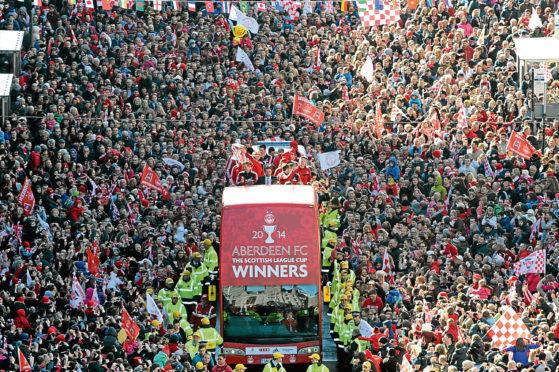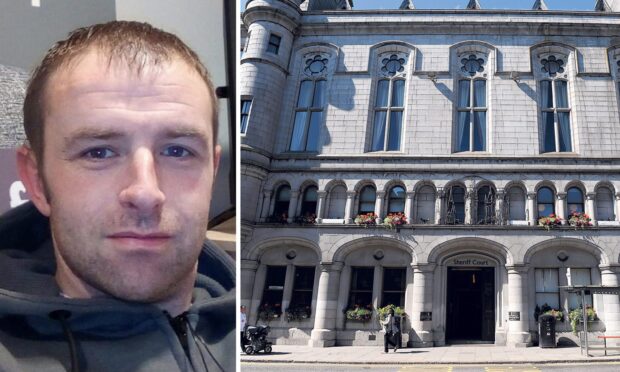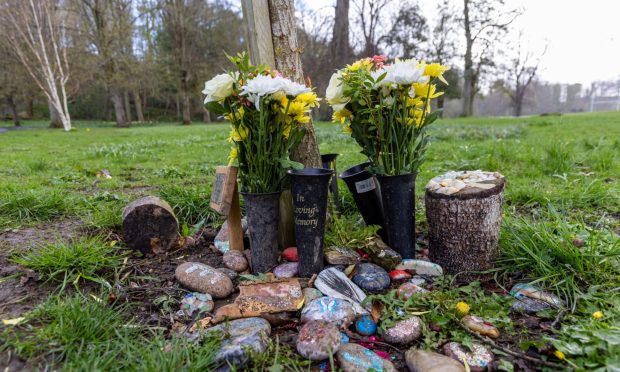The Dons have been an immovable part of the scenery in the north-east of Scotland for well over a century.
Some may say they are as renowned the world over for belonging to Aberdeen as oil and granite.
Since 1903 fans have turned up to watch their side through the highs and lows of the Gothenburg Greats in 1983 to narrowly avoiding relegation in 2000.
But as their supporters’ loyalty remains strong so too does the economic impact of the club on the local economy.
AFC is turning over around £14.5million every year and bosses hope that by 2023 they can grow their revenue to an annual £20million.
But the monetary benefits of the club far exceed 20,000 ticket sales on a sold-out match day.
In an attempt to strengthen the business AFC has recently hired a new commercial manager, Rob Wicks, who they hope will continue to make them a financial success.
But they also believe, in order to keep this going for the next 50 to 60 years, foundations must be laid with a new stadium.
Plans are in motion to move the home of the Reds from Pittodrie in the city centre to a new development at Kingsford, situated between Kingswells and Westhill.
The proposals has instilled excitement among fans who are looking to the future. But it has also been met with opposition from a number of residents living nearby, worried about the potential impact such a major development situated on their doorstep will have on their lives.
Despite being given the green light for the development by Aberdeen City Council last month, the Scottish Government is considering whether or not they should call the decision in, so until then the fate of the Dons’ future home hangs in the balance.
Duncan Fraser, chief executive of the club, said the team’s success was “immeasurable” when it comes to the impact it has on the city and the region’s wider economy and he says that will only improve with the construction of the new stadium.
He said: “The impact of AFC goes well beyond the balance sheet of the football club. Its social and economic impact across the city is massive.
“When the club is doing well the positivity around the whole city is huge. Look at the build up to the cup final last year; if you looked down Union Street the amount of businesses that took it off their own back to get behind us was massive. Suddenly you look down Union Street and it was a sea of red and the players thought this was great.”
Mr Fraser said the team’s international reputation was also a major boost to the area. And he said he hoped that with the development at Kingsford they could help the region grow in its attempts to improve on its tourism offering.
“Another aspect that is really, really important is wherever you go if you ask people about Aberdeen they refer back to the football club,” he said.
“It doesn’t come back to oil and gas, it’s all about Alex Ferguson and Aberdeen and all those days. The impact of the brand is massive.
“It’s a really, really important dynamic within the city and in reality the economics of it are that it supports 130 jobs but it’s something like three times that in terms of the wider economic impact that we have.
“If you look round the restaurants and the bars without Aberdeen Football Club you wouldn’t have the same impact as you currently do, yet alone the impact you would have with the move to a new purpose-built stadium. It is just colossal.
“Opportunity North East (ONE) did a series of road shows and were talking about bringing more tourists into Aberdeen on cruise ships and looking at Marischal street and how they would redesign that.
“We have to become part of that tour that people want to do alongside the golf courses the castles and the distilleries.”
As well as making Kingsford a must-see tourist destination the club hopes to turn the new energy efficient stadium into a venue which can not only be used to hold a multitude of events, but can also be used to educate and train the next generation of north-east greats.
Mr Fraser said one of the biggest benefits of having to go through a long planning process is that they have been able to visit a number of hi-tech stadiums over the last few years, showing them the standards they need to live up to.
He said: “We have been to Brighton, Derby, Leicester, Holland, and when you visit these and it just changes the whole perspective you have because you are starting afresh and building an experience for families to have when they come along.
“When you look at Brighton it’s mind-blowing some of the things it’s achieved. They have a Braille area where people who are blind can go to feel part of it. They got the local supporters club to come up and tell them the 30 best moments of the old stadium and tried to make them part of the new one.
“It is just night and day. The seating arrangements shows the entertainment you can bring, like the facilities and the refreshments. The atmosphere is lifted beyond what you can ever imagine.
“When Pittodrie was built it was built to a level and a standard, when at the time it was the first all-seated, all-covered stadium in the UK.
“We were the first seated stadium in the UK. We were miles ahead, but you know what that was 35 years ago and it looks it. At the moment our training facilities are in different parts all over the city. We are so behind.”
The chief executive said that as well as being behind in technology Pittodrie is costing the club £400,000 a year in “sunk costs” due to it being so dated and energy inefficient.
But potentially one of the most important things the club wants to highlight about the new stadium is the benefits it could have on the locals.
Mr Fraser added: “The design of the inside of the stadium is almost like asking ‘what do you want in there?’ It will be designed by the fans.
“It can be used for absolutely anything. If you look at the old stadiums, some of them you don’t even know where the entrance is.
“If you go to a new stadium there are people all over it all the time. I think one of the things that’s so important is that we need to turn people’s minds around. OK you may think that it is a challenge but we need to be asking people ‘what is it that you want from the new stadium’.
“Coventry has got creche facilities, the local health board have a suite there. The key point that came out during the hearing, a lot of councillors didn’t appreciate is that already there are things happening at Pittodrie. But part of the problem is that part of the concourse has pillars that stop you opening up that concourse space. There are 7,000sq metres of concourse space available at this new stadium and that’s multi-use space. That could be badminton courts, basketball courts, anything.”
And while the club still needs to secure all the funding for the £50million development, which includes a community sports hub, training academy and the stadium, a study carried out by the Aberdeen and Grampian Chamber of Commerce showed the economic benefit to the north-east would result in the equivalent of 443 new construction jobs worth more than £8.5million.
As the club edges closer and closer to securing its new home, appointments have been made to ensure AFC is raking in enough cash to make its revenue goals over the next five years.
Commercial director, Rob Wicks, will take up post with the club next month from Powerboat P1 Management where he has been working as managing director. With 17 years’ experience in sports marketing, he says he is looking forward to the new challenges football has to offer.
He said: “A lot of the reading I have been doing of late talks about the importance of engaging with fans in a new way and building a stadium that is built around the business and allows us to be functional as a business.
“It is so important for us to cater for the fans because if we cannot get that engagement with the fans they end up being turned away. Duncan said, Pittodrie is getting to an age now where without a move you are going to be struggling.
“The opportunity to build a new stadium which is purpose-built and caters directly for the fans is a fantastic opportunity. The other thing that is really important is to make it a significant attraction for foreign visitors as well.
“I think that’s really important. I think if you look at what people come to visit in Aberdeen and Aberdeenshire currently the stadium isn’t in the top 10 and it should be. There are lots of foreign connections with Aberdeen and Aberdeenshire from a tourism and business perspective and the stadium should be right up there. A purpose designed state-of-the art stadium will draw in new people and boots economic numbers.”
Mr Wicks said he planned to talk to an inhouse team about how they can engage with fans and what their views are on initiatives they hope to launch in the next few months.
He also said he was keen to try to tap into the America market and elevate Aberdeen FC as the US’s Scottish team.
He added: “It’s really interesting the internal perception to hear how they think we can move things forward.
“These schemes and initiatives will include looking at how the tentacles of Aberdeen football club spread globally and how to capture a global audience.
“That reiterates the brand of Aberdeen Football Club helps with the brand of city and shire and the more the club is promoted internationally the better the impact on the region.
“You are seeing the demand for television increasing. There’s a nice growth in TV numbers last couple of seasons. It’s about brand Aberdeen being seen further and further afield and football has always been a global business. But when you see what Man City is doing with club partnerships and affiliations the world over – what’s to say a club like Aberdeen cannot facilitate that kind of thing going forward?
“We have some fantastic new investment coming into the club from the US through Dave Cormack and he is really keen to develop a really strong US Scottish partnership that’s massive untapped milage.
“You are seeing growth of soccer in the US and great opportunities to position Aberdeen as America’s Scottish club. I think there is great scope for that.”
While the club is currently on a strong financial footing Mr Fraser said they cannot be complacent when it comes to raising funds for the new stadium.
He said despite the Dons not being badly affected in terms of ticket sales and sponsorship in the wake of the oil and gas downturn he said times had still been challenging.
Mr Fraser said they had big plans to raise money for the project which included selling the stadium rights.
“We know raising the funds is going to be a challenge but put it this way, it’s far easier to raise money for a project that’s real, because you can’t go knocking on people’s door with a plan,” he said. “It’s got to be real. That has always been the issue. There’s 60% of funding for the training facilities already in place.
“The stadium – the sale of Pittodrie makes up a lot. Rob has been looking at the marketing around the stadium rights – it’s the first one that’s the big one and the founding partner’s names never disappears.
“The club still has planning permission for development at Pittodrie, that is still intact. We are very open in terms of public bid for that, if other opportunities come along and people think the land can be used for something better then it might be looked at again.”
For the chief executive, a man with an enormous level of responsibility to deliver the goods, everything has its cost.
He said: “What do we want to deliver? We want to deliver a successful football club. Aberdeen is doing fine, we break even every year we do all the right things, but that alone, going into a new stadium isn’t enough.”
But just like moving home, leaving Pittodrie, a building that saw every victorious win, every bitter loss, and heard the chant of thousands, is a nostalgic but none the less necessary affair for the board.
Mr Fraser said; “It will feel really strange not having Pittodrie there. We did look at taking the old gates at the King Street end, trying to take them as part of a memorial garden. You have to take certain pieces of history with you. We have to find ways and means. It will always be a site where people will remember there being a football stadium. There will always be a feeling that there was once a football stadium there.
“I suggest they name the new streets around Pittodrie after the Aberdeen Greats. Some people who have left a mark on the city. That would be great.”
You look down Union Street and it was a sea of red and the players thought this was great










